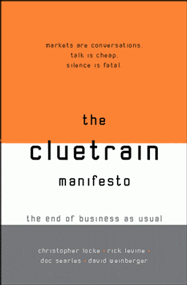 What can the early Internet classic, the Cluetrain Manifesto tell us about creating customer connections in today’s the social web? Evidently, alot.
What can the early Internet classic, the Cluetrain Manifesto tell us about creating customer connections in today’s the social web? Evidently, alot.
“The industrial interruption of the human conversation — is coming to an end. On the Internet, markets are getting more connected and more powerfully vocal every day. These markets want to talk, just as they did for the thousands of years that passed before market became a verb with us as its object.”
Old Wine, Old Bottles
As poignant today as it was back in 1999, this encapsulating quote from the great Internet treatise, the Cluetrain Manifesto serves to restate the principles, promise and perils of the Web. And yet, more than a decade on, in a world immersed in social media, companies continue to be hesitant to harness the enormous potential that lies literally right under their noses. A good indication of the preferred mode of engagement comes from annual advertising spending. Of the $154 billion spent on advertising in the US, 80% of it goes to traditional, one-way channels of TV, radio and print, the remaining 20% to the Internet according to eMarketer. It’s no wonder that over a decade since the keen observations of the Cluetrain, companies continue to lag behind consumers and the markets they occupy, remaining literally clueless. Certainly the limits are no longer technological. With nearly one billion active users on Facebook world-wide, and some 250 million tweets per day, consumers have never been so accessible. Still, businesses struggle to fully join the conversation and engage their customers one-to-one.
“Ever since the Web showed up, business-as-usual has desperately tried to pipe-weld it onto the back end of TV’s history. But it won’t work on the Web, because networked markets aren’t passive spectators waiting to receive the next marketing message.”
Customers don’t go online to be marketed to. But that doesn’t mean that they would desire a commercial-free web. They’re there to engage with their extended social networks and indeed, that includes the companies and brands they are interested in. Yet strangely, many companies seem to prefer to continue to push and pop advertising in the old fashioned way. Is it any wonder that they many continue to debate the value of Facebook and find themselves pushed ever further to the periphery of web sites? Thank goodness our screens are getting wider! But even if marketing and advertising agencies continue to council traditional channels and strategies, new modes of customer engagement are happening at the very center of the action online.
New Wine….
As anyone who does even a moderate amount of surfing can attest, people love to talk about the products and services they use. Good or bad, these dialogues are golden. Less so to marketers who are abstracted from from the process of creating products and user experience, but rather to the people who innovate, design, manage and support them. Today it is difficult to find a Product Management blog online that isn’t talking about capturing and managing customer feedback. There are more than a few companies providing these kinds of social media aggregation tools. But the real magic comes in the ability to integrate these gems directly into the requirement scoring process and ultimately the product roadmaps that mark the way to the next killer release.
In the process of integrating tools like OneDesk, it’s the product managers who may be the first in the enterprise to harness the Internet in the manner envisioned in the Cluetrain, to turn the social web into a lively marketplace which listens and reacts and knows its customer they way they want to be known.
“If you want to hear the sound of the new marketing, listen to these conversations coming from inside, outside, over, and above even the hardest-shelled companies that still think marketing means lobbing messages into crowds. Here is the same sound our ancestors heard in those ancient marketplaces, where people spoke for themselves about what mattered to them.”
